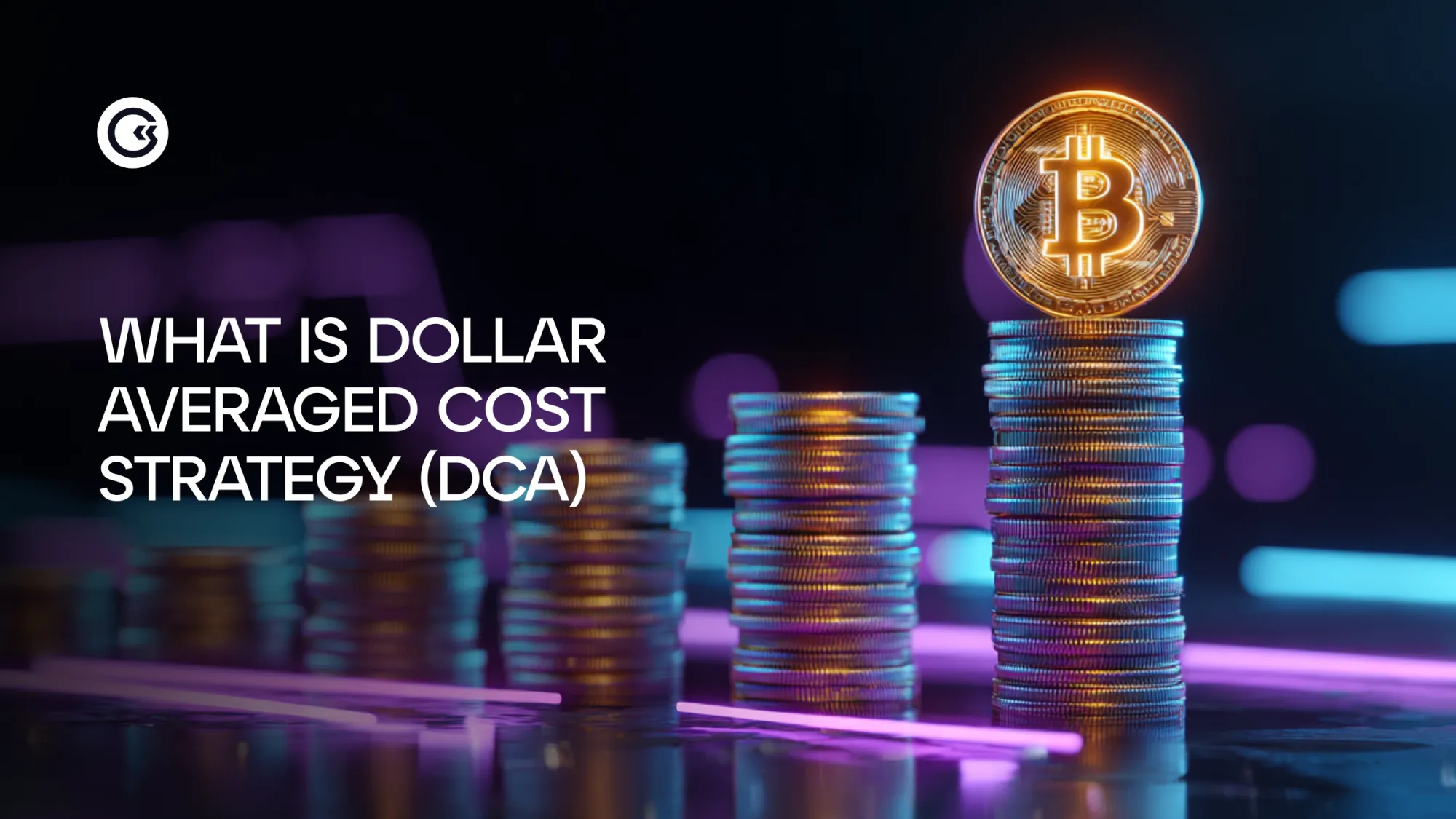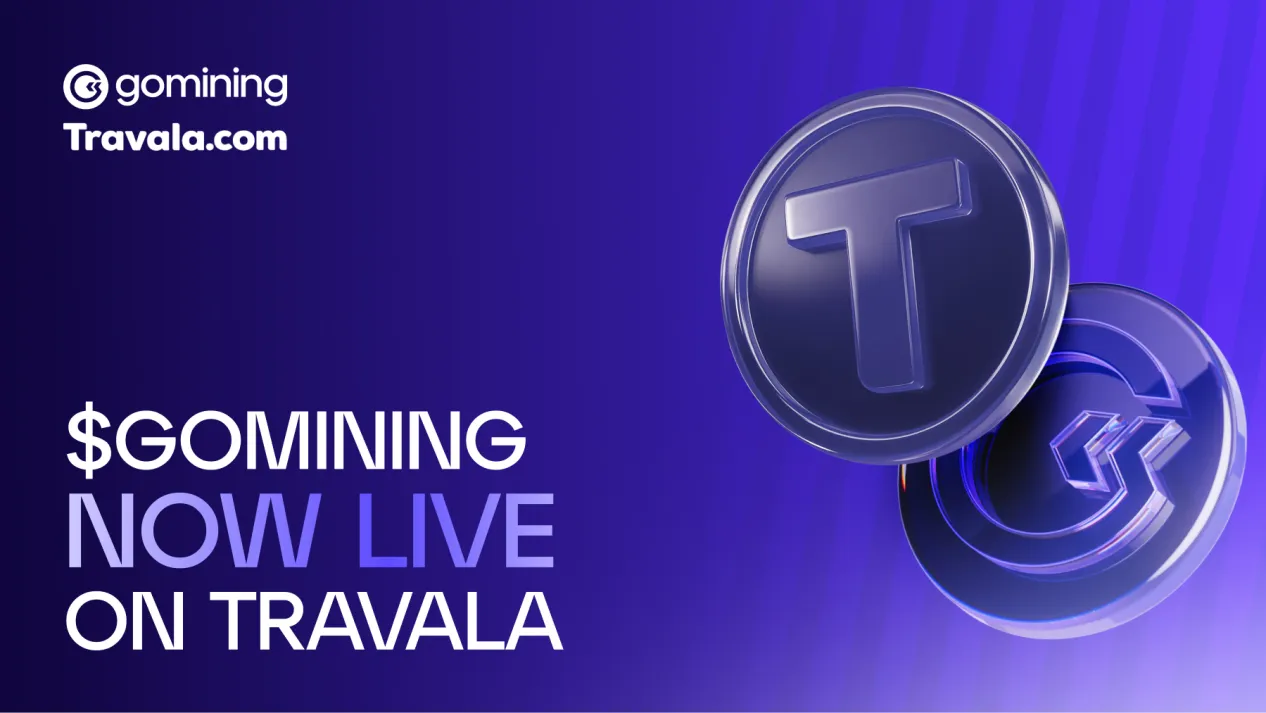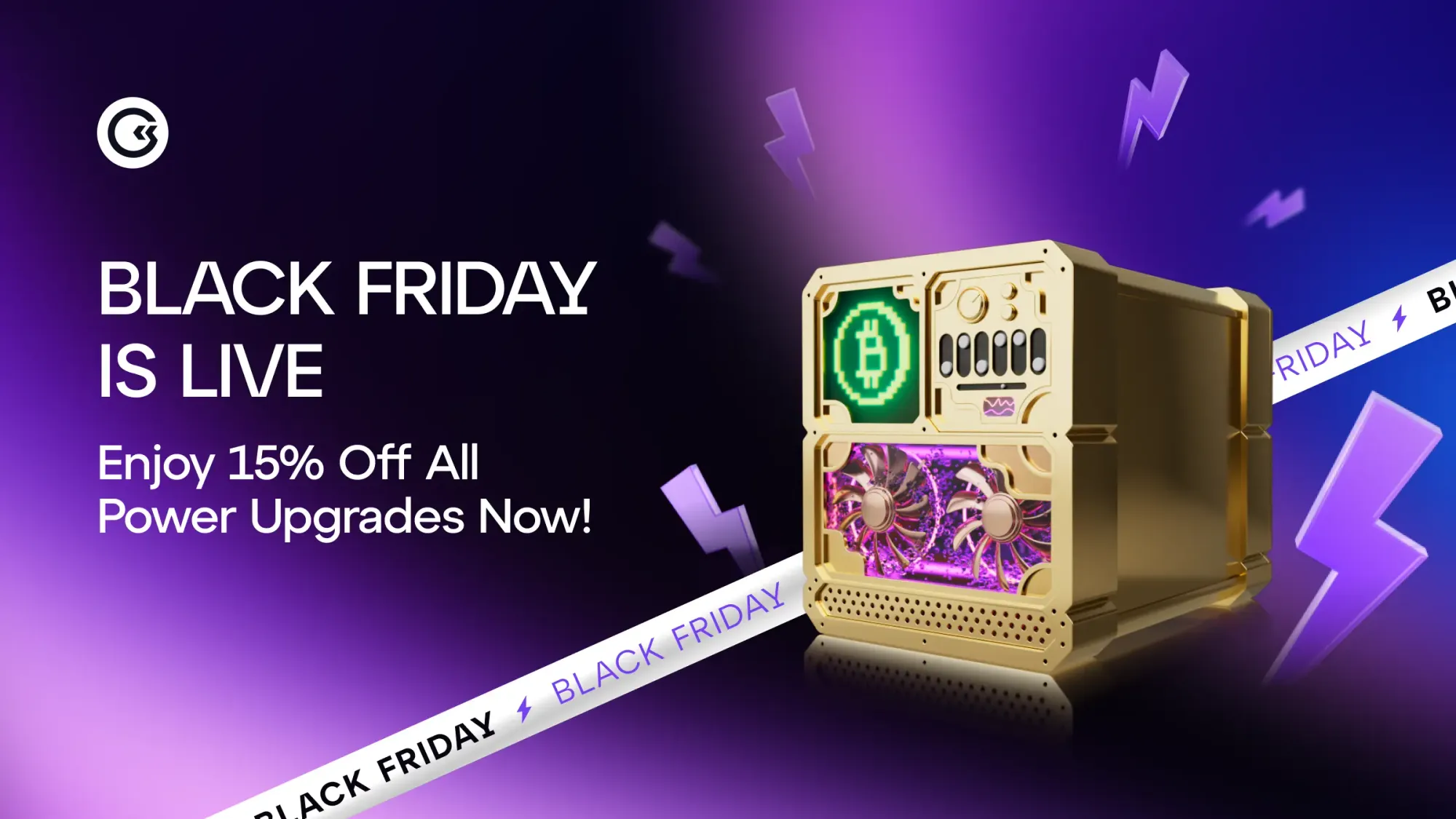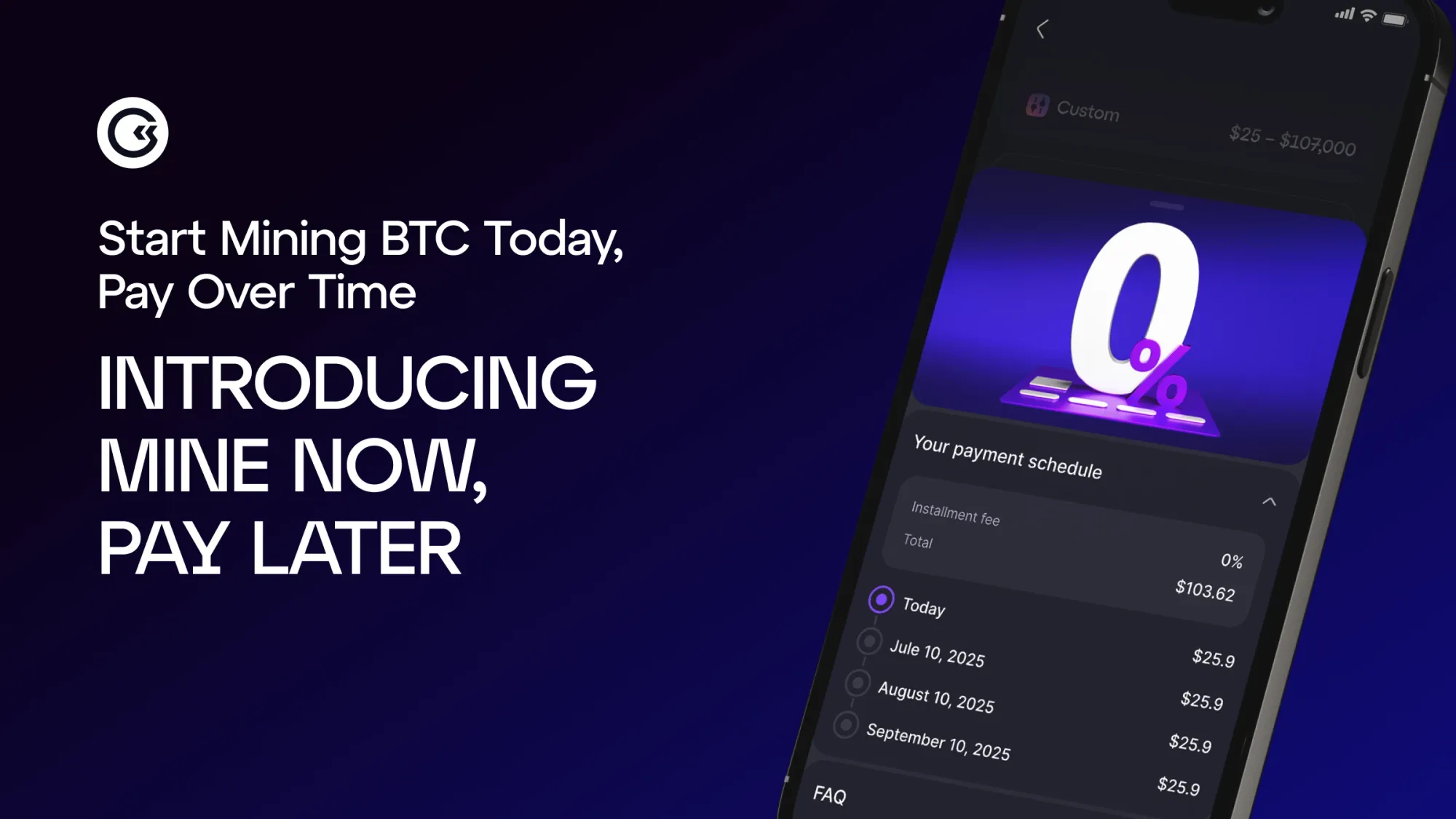Imagine you want to buy Bitcoin but you’re afraid of buying at the top and losing money. Or the opposite — you keep waiting for the “perfect moment” that never comes, and the coin already “flies to the moon.” Familiar? That’s exactly why smart investors use the DCA strategy — Dollar-Cost Averaging.
It’s not a magic pill for instant wealth, but it’s one of the simplest and most reliable ways to enter crypto without stress or anxiety. Let’s break down how it works in practice, who it’s for, and how not to mess it up in 2025–2026.
The Essence of DCA in Simple Words: Buy Gradually, but Regularly
The concept is so simple it seems almost trivial: instead of investing all your money at once, you buy crypto in small portions at regular intervals — weekly, monthly, or quarterly.
Real-life example: You have $1,200 you’re ready to invest in Bitcoin. Instead of buying today at $45,000 with the full amount, you split the sum across 12 months — $100 each month.
- January: Bitcoin is $45 000 → you buy for $100
- February: it drops to $38 000 → again $100 (but now you receive more satoshis)
- March: it rises to $52 000 → another $100
- And so on throughout the year
By the end of the year, your average purchase price is smoothed out somewhere in the middle of these market swings.
You didn’t catch the bottom — but you didn’t buy the peak either.
A real example of DCA investing in Ethereum showed that starting from January 1, 2021, an investor who invested $250 monthly ended up with approximately $1760 profit in dollar terms after 16 months.
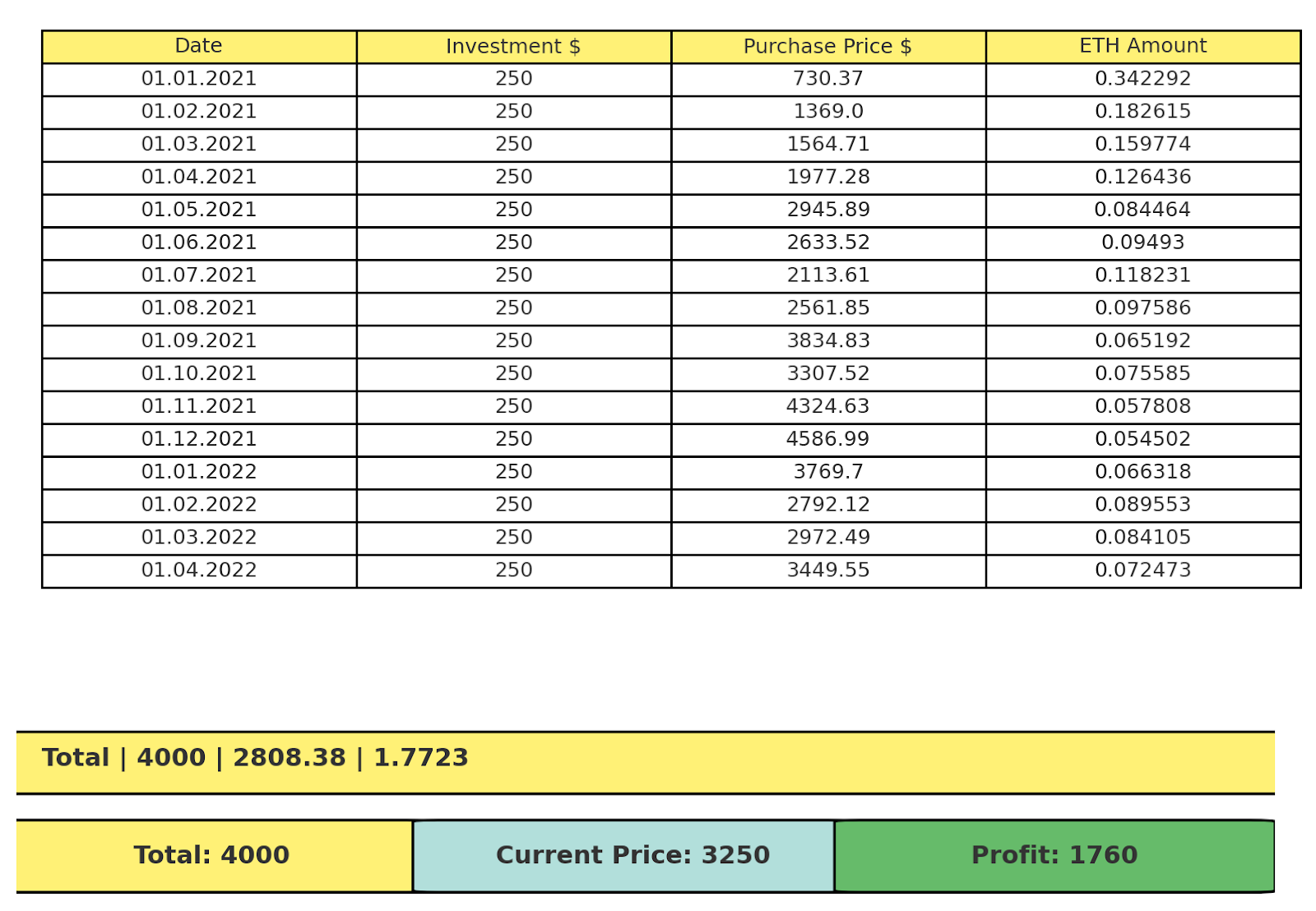
Source: decenter.org
Why DCA Works in Crypto Better Than Anywhere Else
The crypto market is a rollercoaster on steroids. Bitcoin can dump 30% in a week and then pump 50% in a month. Ethereum is $4000 yesterday, $2500 today, $3500 tomorrow. Try guessing!
That’s why DCA is especially powerful here:
- Volatility works in your favor. When the price drops, you buy more coins for the same amount of money. When it rises, you buy less — but the coins you already accumulated increase in value. As a result, you automatically “buy cheaper” during dips.
- Emotions don’t interfere. No need to stare at charts 24/7 thinking: “This is it, the bottom!” You simply set up automatic weekly purchases — and live your life peacefully.
- Reduced risk of “losing everything.” Imagine putting $10 000 into a random hype coin at the top… and it crashes 80% within a week. Game over. But if you invested $1,000 per month, after the first drop you’d simply buy cheaper, average your entry down, and might break even (or profit) on recovery.
How It Works With Real Numbers: Bitcoin Example
Let’s look at actual data, using 2022–2023 — a bear market and early recovery period:
Scenario 1: Lump-Sum Purchase
- January 1, 2022: You invest $12 000 at Bitcoin price $47 000
- You buy: 0.255 BTC
- By November 2022 Bitcoin falls to $16 000
- Your portfolio: $4080 (–66%)
Scenario 2: DCA — $1000 per month
- You buy $1000 worth of BTC every month regardless of price
- Your average entry price ends up around $25000
- Total accumulated: 0.48 BTC
- By January 2024, at Bitcoin $45 000 → portfolio = $21 600
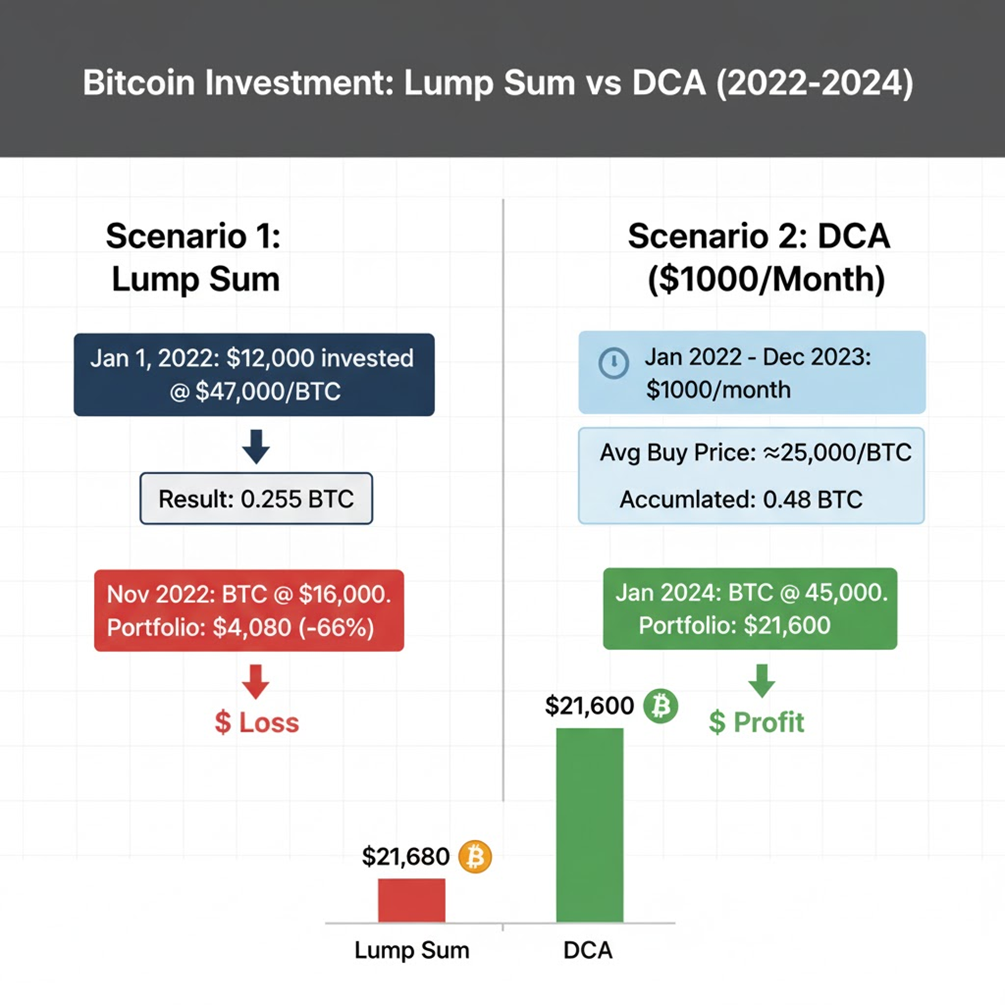
Source: gemini.google.com
Even without catching the bottom, the DCA investor accumulated almost twice as much BTC and returned to profit much faster.
Step-by-Step: How to Start Using DCA Tomorrow
Step 1: Set your budget. Decide how much you can invest without harming your lifestyle. This should be “free” money you don’t plan to touch for at least 1–2 years. Don’t borrow, don’t take out loans, don’t sell your grandma’s apartment.
Step 2: Choose your cryptocurrencies. Start with large-cap leaders:
- Bitcoin (BTC) — digital gold, the most reliable
- Ethereum (ETH) — the backbone of DeFi and smart contracts You can add Solana (SOL), BNB, or other top-20 names. See CoinMarketCap.
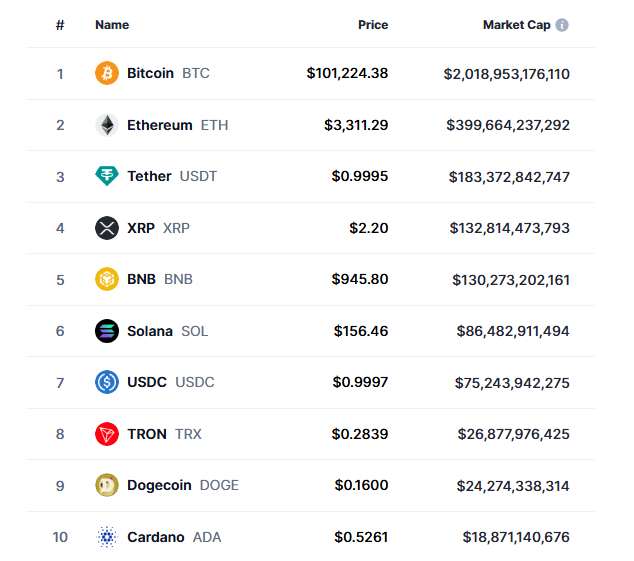
Source: coinmarketcap.com
Avoid obscure altcoins and memecoins for DCA — they can vanish within a year.
Step 3: Set your purchase frequency.
- Weekly — for the active and patient
- Biweekly — optimal for “salary-based” investing
- Monthly — the classic, fits most peopleThe key is consistency. Don’t skip, even if the market feels “too high.”
Step 4: Automate the process. Most exchanges (e.g., Binance, Coinbase, Kraken, Bybit) offer Recurring Buy / Auto-Invest features. Set it once — the platform will execute on schedule.
Step 5: Store safely. If you plan to hold longer than a year, move coins to a hardware wallet (e.g., Ledger, Trezor) or at least a self-custody wallet. Don’t leave everything on exchanges — the stories of FTX and Mt.Gox should be enough of a warning.
Step 6: Track, but don’t obsess. Check your portfolio quarterly: average entry and overall P/L. Don’t check daily — volatility will drive you crazy.
Key Metrics for a DCA Investor in 2025
To understand whether you’re on track, monitor:
Average Purchase Price (cost basis). Your goal is to keep the average below current market price. Most exchanges and apps calculate it automatically. On exchanges:
- Binance → Portfolio → PNL
- Bybit / OKX → Assets → Cost Basis
Trackers:
- CoinStats
- Delta App
- CoinTracking (detailed cost basis)
- CoinGecko Portfolio
If you want it right on your charts — use TradingView → indicators like “Average Entry” / “DCA”.
Total Accumulated Amount. How many coins you’ve already purchased. For example, at $200/month for a year you’ll buy $2,400 at entry cost, but market value may be higher or lower. On exchanges: Balances / Portfolio For clean accumulation visuals:
Unrealized Profit/Loss. The difference between invested capital and current portfolio value. In DCA it may be negative for months — that’s normal. On exchanges: Unrealized PnL For charts & history:
- CoinTracking
- Accointing
- Power users: Google Sheets + exchange API → Google Sheets
Cost Basis Reduction (%). How much DCA lowered your average entry versus a one-shot buy at the start. More volatility → higher potential reduction. Few apps show this directly, but you can analyze via:
Related on-chain metrics:
- MVRV (Market Value to Realized Value) — shows whether a coin is overpriced vs. holders’ realized cost. Below 1 can be a good DCA zone.
- Net Unrealized Profit/Loss (NUPL) — market emotion indicator. In “capitulation” (red), DCA tends to perform best.
- Exchange Reserve — coins held on exchanges. Falling reserves imply outflows to cold storage (bullish for long-term DCA).
You can track these on CoinGlass, Glassnode, CryptoQuant, and DeFiLlama.
Where to Find Quality DCA Charts
- ✅ LookIntoBitcoin – DCA Backtest — shows historical DCA results by start dates.
- ✅ DCA Calculator (BTC/ETH) — very simple and handly:

Источник: bitcoindollarcostaverage.com
- ✅ Glassnode (some data free) — deep charts: Cost Basis, Realized Price, SOPR, Profitability
- ✅ CryptoQuant — market psychology + P/L, HODLers, profitability levels
- ✅ TradingView — “DCA Backtester” indicator (search “DCA Backtest”)
5 Advantages of DCA: Why It Works for Beginners
- Psychological comfort. You don’t agonize about timing. No FOMO, no panic. You just follow a plan.
- Investment discipline. DCA trains you to save and invest regularly — a habit that works beyond crypto.
- Volatility smoothing. You average your entry over market swings — extra important in crypto where prices can swing 20% in a day.
- Fewer emotion-driven mistakes. Newcomers panic-sell on dumps and chase tops on pumps. DCA removes that from the equation.
- Any budget. You can start with $10–20 per week. No need for thousands upfront.
5 Risks & Drawbacks: What Gurus Don’t Tell You
- In strong bull markets, DCA can underperform lump sum. If price only climbs (2020–2021 style), a one-shot buy at the start often wins. But who knew in advance?
- Fees can eat into returns. Small, frequent buys rack up fees. Weekly DCA at $50 with a 0.5% fee is $0.25 each time → ~$13/year. Small in dollars, but a noticeable % of tiny tickets. Fix: choose low-fee venues (Binance, Bybit, OKX), use maker orders, or zero-fee DCA bots.
- You might miss the absolute bottom. Strict calendars won’t “go all-in at the bottom.” Philosophical point: could you really call the bottom anyway?
- Tax overhead from many trades. Some countries treat each buy as a tax lot. Weekly DCA = 52 lots/year. Consider Koinly or CoinTracker for automation.
- Dead-coin risk. DCA won’t save a failing project. Stick to robust assets — ideally top-30 by market cap.
DCA and Other Strategies: How to Combine
- DCA + HODL. The classic. Buy steadily and hold for years. Ideal for BTC and ETH.
- DCA + Staking. Route DCA’d coins into staking (ETH, SOL, ADA, DOT) for an extra 4–10% APY. Choose reputable validators or liquid staking solutions like Lido and Rocket Pool.
- DCA + DeFi Yield Farming. Riskier. DCA into stables (USDC, USDT) and deploy into Aave/Compound for 5–15% APY. Be mindful of smart-contract risk and hacks.
- DCA + Rebalancing. Quarterly or semi-annual rebalancing. Example: start 70% BTC / 30% ETH; if BTC rallies to 85%, trim and add to ETH to lock in gains and maintain balance.
- Aggressive DCA (Averaging Down). If a coin drops hard, you temporarily increase your DCA size (e.g., $100 → $200/month) to lower the average entry. Risky — only if fundamentals are strong.
Outlook for 2025–2026: 7 trends for DCA
- Bitcoin halving in 2024 and its aftermath. The halving occurred in April 2024. Historically, 12–18 months later we see a bull cycle. If the pattern repeats, 2025 may be an uptrend year — DCA now/early-2025 may pay nicely by year-end.
- Institutional adoption via Bitcoin ETFs. U.S. spot Bitcoin ETFs were approved in January 2024, opening doors for institutions. According to CoinGlass, inflows in the first months exceeded $10B — creating a long-term demand backdrop, ideal for DCA.
- Ethereum and Layer 2 progress. Post-Merge Proof-of-Stake and L2s (Arbitrum, Optimism, Base) lowered fees and improved throughput — making ETH more attractive for long-term DCA, especially with 3–4% staking yields.
- Regulation. 2025–2026 will bring active rule-making in Europe (MiCA), the U.S. (potential stablecoin laws), and Asia. Short-term volatility is possible, but long-term stability and predictability favor DCA participants.
- AI-driven DCA automation. AI bots that read on-chain metrics and sentiment to modulate DCA sizes (e.g., buy more in “extreme fear”) will become more accessible in 2025–2026.
Expert view: “DCA remains one of the most reliable strategies for retail investors. In the macro uncertainty of 2025, bottom-picking is a fool’s errand. Regular BTC and ETH purchases with a 3–5 year horizon are a prudent approach,” notes a Glassnode analyst in a report.
6 Common DCA Mistakes and how to avoid them
- Stopping DCA at the bottom. That’s when you should buy the most — psychologically hard, but financially rewarding.
- DCA into memecoins. Shiba, Pepe, Wojak can do 1000% — but most die. DCA is for assets with fundamentals.
- Buying too frequently. Daily $5 DCA = 360+ tx/year. Fees add up; taxes get messy. Weekly/biweekly is optimal.
- No diversification. Only BTC or just one alt. Better: 50–60% BTC, 30–40% ETH, 10–20% other promising top-30 names.
- Panic-selling at a loss. If you capitulate after a 40% drawdown, DCA’s purpose is defeated. DCA = patience (1–2 years minimum).
- Ignoring withdrawal fees. Weekly buys + immediate withdrawals can rack up $5–$20 network fees each time. Accumulate on-exchange and withdraw monthly/quarterly.
Tools and Services for DCA in 2025
Exchanges with automated DCA:
- Binance Auto-Invest — 100+ coins, fees from 0.1%
- Coinbase Recurring Buy — beginner-friendly, higher fees (up to 1.5%)
- Kraken Pro Automated Strategies — low maker fees
- Bybit Smart DCA Bot — works on spot & futures
DCA bots:
- 3Commas — advanced DCA bot with take-profit / stop-loss
- Bitsgap — connects to 15+ exchanges, GRID + DCA strategies
- Pionex — built-in bots incl. DCA, low fees
Analytics platforms:
- CoinGecko — portfolio & average cost tracking
- Delta App — mobile tracker with DCA metrics
- CoinTracker — tax tracking for all DCA purchases
On-chain analytics to optimize DCA:
- Glassnode — MVRV, NUPL, Exchange Reserves
- CryptoQuant — exchange inflows/outflows
- Santiment — social + on-chain signals
DCA in the Context of Other Crypto Trends
- DCA & DeFi. You can DCA into positions, not just tokens — e.g., regularly add liquidity to Uniswap or Curve pools. More complex, but you earn pool fees.
- DCA & NFTs. Some DCA into floor-price NFTs in “promising” collections. Riskier: NFT markets are less liquid.
- DCA & Staking/PoS. After DCA’ing into ETH/ADA/SOL/DOT, stake for 3–10% APY. Beware lock-ups.
- DCA & Mining. Instead of coins, DCA into hardware (ASIC/GPU) to grow hashrate — requires cheap power and technical know-how.
- DCA & Crypto Indexes. DCA into index funds (e.g., Bitwise 10 Crypto Index Fund) or DeFi indices on Index Coop — instant diversification.
How to Measure Your DCA’s Effectiveness
Average price formula: Average Price = Total Invested / Total Coins Purchased
Example:
- Month 1: buy 0.01 BTC for $450
- Month 2: buy 0.012 BTC for $450 (price fell)
- Month 3: buy 0.009 BTC for $450 (price rose)
- Total spent: $1350; total bought: 0.031 BTC → Average = $1350 / 0.031 = $43 548
- If BTC is $50,000, portfolio ≈ $1,550 → +14.8%.
ROI (Return on Investment): ROI = ((Current Value − Invested Capital) / Invested Capital) × 100%
Compare with Lump Sum: Periodically check how you’d have done if you invested all at once on day 1 — useful for understanding DCA’s performance in the given regime.
The Psychology of DCA: How Not to Break
- When the market drops 50%: remind yourself you’re buying twice as many coins for the same money. It’s a sale.
- When friends brag about 10× memecoin gains: for every winner there are thousands of blown accounts. You’re playing the long game.
- When you want to “wait a bit longer”: waiting for perfection is procrastination. The second-best time is today. Start small — even $20.
- When “it feels too late”: BTC was $1 → $10 → $100 → $1000 → $10 000 → $50 000. People said “too late” every step of the way. If you believe in long-term adoption, it’s never too late to start DCA.
FAQ: Quick Answers
What is Dollar-Cost Averaging (in plain English)? Buying small amounts at fixed intervals (e.g., $100 every Monday or $500 on the 1st of each month) to smooth your entry over time.
How does DCA work in crypto? Pick a coin (BTC/ETH), pick an amount and a cadence (weekly/monthly), set automation or follow a calendar manually. Over time your average entry smooths out, reducing reliance on short-term price swings.
Pros & risks? Pros: lower emotional stress, smoother entries, discipline, works for small budgets. Risks: can underperform in a straight-up bull, fees on many small buys, won’t save you from picking a bad asset.
How to use DCA in 2025? Favor BTC/ETH, choose comfortable sums & cadence, automate on an exchange, withdraw to cold storage quarterly, hold 1–2+ years. Track on-chain metrics (MVRV, NUPL) to sense the market phase.
Which metrics matter? Average cost, accumulated amount, unrealized P/L, cost-basis reduction %; on-chain: MVRV, NUPL, Exchange Reserves.
Can DCA make money? With a 2+ year horizon, robust assets, and no panic — historically, 4-year BTC DCA windows have been profitable 100% of the time. Past performance ≠ guarantee of future returns.
Typical mistakes? Stopping at bottoms, DCA’ing memecoins/scams, buying too often, no diversification, panic-selling, ignoring tax/withdrawal fees.
Impact on the market? Retail DCA creates consistent demand regardless of price, stabilizing markets. Institutional DCA (ETFs, corporates) can shape long-term trends.
Real Cases: DCA Wins and Fails
Case 1: Bitcoin DCA since 2018. Investor DCA’d $200/month starting Jan 2018 (post-$20k crash). Over 5 years (2018–2023), invested $12,000. Average cost ≈ $15 000. By Dec 2023 at $42 000, portfolio ≈ $33 600 (+180%). Lump-sum at $13 000 in Jan 2018 would be ≈ $38 769 — a bit more, but with higher risk.
Case 2: DCA failure in Terra/LUNA. Investor DCA’d $500/month from Oct 2021 to Apr 2022 (total $3500). In May 2022, the project collapsed due to the UST algorithmic stablecoin failure. LUNA fell ~99.99%. Nearly total loss. Lesson: DCA doesn’t fix broken fundamentals.
Case 3: Mixed strategy. Investor DCA’d $300/month: $150 BTC, $100 ETH, $50 into a DeFi index (Index Coop). Also staked ETH via Lido (~4% APY). Over 3 years (2021–2024) invested $10 800; portfolio grew to ≈ $16 500 including staking rewards (+52.7%). Conservative but steady.
Case 4: Aggressive DCA at the bear-market bottom. Trader did standard $200/month ETH DCA, but when price hit ~$1000 in June 2022, increased to $600/month for 6 months. Average entry fell to ~$1400. By Jan 2024 at ~$2400, return ≈ +71% vs +40% with standard DCA.
DCA & Macroeconomics: External Forces
- Central bank policy. Rate hikes (like 2022–2023) pressure risk assets; investors rotate to bonds/USD — a good time for aggressive DCA. When cuts arrive (expected late-2024/2025), liquidity returns to risk assets — crypto benefits.
- Inflation & fiat devaluation. In high-inflation countries (Argentina, Turkey, Venezuela), DCA into Bitcoin can preserve purchasing power (regularly converting part of salary to BTC).
- Geopolitics. Wars, sanctions, banking crises (e.g., Silicon Valley Bank in March 2023) push people toward alternatives. Bitcoin as “digital gold” is prized for sovereignty.
- Tech breakthroughs. Lightning Network adoption, Ethereum L2 growth, and new chains (Aptos, Sui) influence long-term value of assets you DCA into.
Taxes & Legality: Things to Remember
- U.S.: Every sale/exchange/spend is taxable. Each DCA buy creates a new lot with its own cost basis. Use FIFO or specific identification. Long-term gains (held >1 year) are taxed at 15–20% vs. ordinary income rates up to 37% for short-term.
- Europe: In Germany, crypto held >1 year is tax-free upon sale. Portugal historically had no tax on individual crypto gains (subject to change). Elsewhere in the EU, capital-gains rates often 15–30%.
- CIS countries: Evolving frameworks. For example, Russia is moving toward fuller regulation of mining and crypto turnover from 2025. Always verify current rules.
Alternatives to DCA: When to Consider Other Approaches
- Lump Sum. If you’re confident we’re at a deep bear-market bottom (e.g., BTC −80% from ATH), a one-shot buy may outperform — but it takes conviction and analysis.
- Value Averaging. You set a target portfolio growth path; buy more if lagging, buy less (or sell) if ahead. More complex, sometimes more effective.
- Momentum Investing. Buy only in strong uptrends. Requires TA and active management — philosophically opposite to DCA.
- Buy & Hold. One-time purchase held 5–10 years, no adds. Minimal actions, requires a larger initial sum and iron nerves.
- Seasonal DCA. Buy in specific months. Historically, BTC can be weaker in June–September — more aggressive DCA then; October–December often stronger — reduce or pause.
Conclusion: DCA Is a Marathon, Not a Sprint
Dollar-Cost Averaging isn’t a magic wand. It’s discipline, patience, and conviction in crypto’s long-term future. You won’t catch exact bottoms or snipe the very first pumps — but you also won’t blow up your account in week one.
To ground the fundamentals, start with the basics: subscribe to Crypto Academy and get access to the free course “Bitcoin and Mining” → https://academy.gomining.com/courses/bitcoin-and-mining
Telegram | Discord | Twitter (X) | Medium | Instagram
November 7, 2025


